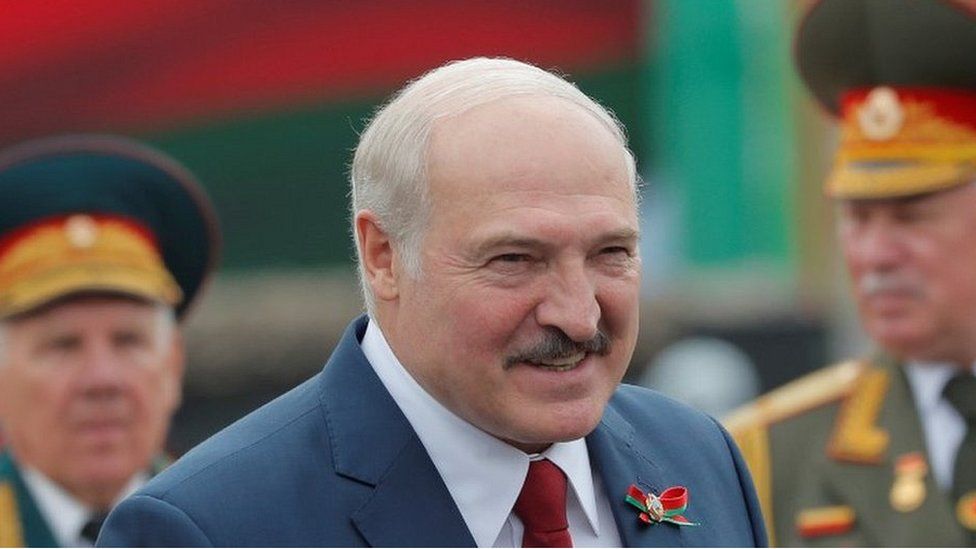Alexander Lukashenko: From Military Service to Political Ascendancy – A Comprehensive Exploration of His Early Years

Introduction:
Alexander Lukashenko, the President of Belarus since 1994, has been a prominent figure on the international stage due to his long-standing tenure and the unique political landscape of Belarus. This article will provide an in-depth examination of Lukashenko’s early years, focusing on his military service and the formative period of his political career that eventually led to his ascendancy as the leader of Belarus.
Military Service:
Alexander Lukashenko’s journey into public life began with his military service in the Soviet Army. Born on August 30, 1954, in the village of Kopys in the Mogilev Region of Belarus, Lukashenko entered the Homel Higher Military Aviation School of Pilots in 1975. He pursued a career as a military officer, specializing in aviation and flight operations. His training and service in the Soviet military laid the foundation for the disciplined and authoritative leadership style that would characterize his later political career.
Lukashenko served in the Soviet Army for more than a decade, with his military career culminating in the rank of major. During this period, he gained experience in both administrative and operational roles, developing a deep understanding of command structures and discipline within the military. The skills and mindset cultivated during his military service would significantly shape Lukashenko’s approach to leadership in the years to come.
Early Political Career:
The political journey of Alexander Lukashenko took root in the wake of the dissolution of the Soviet Union in 1991. Belarus, having gained independence, embarked on the challenging path of establishing its political identity. Lukashenko’s political career took off when he was elected as the chairman of the anti-corruption committee of the Belarusian parliament in 1993. This marked his initial foray into politics, where he demonstrated a commitment to rooting out corruption, a theme that would become central to his political discourse.
- Presidential Campaign and Election (1994):
- Lukashenko’s political ambitions escalated rapidly, leading to his decision to run for the presidency of Belarus in 1994. His presidential campaign focused on populist rhetoric, promising stability, economic reforms, and an anti-corruption agenda. His military background and strongman image appealed to a significant portion of the electorate, particularly those nostalgic for the stability of the Soviet era.
- The 1994 presidential election saw Lukashenko emerge victorious, securing a mandate to lead Belarus. His presidency commenced on July 20, 1994, marking the beginning of an era characterized by centralized control and a consolidation of power that extended far beyond what many observers had initially anticipated.
- Authoritarian Style and Consolidation of Power:
- Lukashenko’s early years in office were marked by a swift consolidation of power. He embarked on constitutional amendments that expanded presidential authority, curtailed parliamentary influence, and extended his term in office. These changes laid the groundwork for an increasingly authoritarian regime, with Lukashenko at the helm.
- His governing style, often characterized by a centralized and authoritative approach, led to the erosion of checks and balances within the political system. Opposition voices were marginalized, media freedom was restricted, and political dissent was met with repression. The early years of Lukashenko’s presidency set the tone for the enduring authoritarian nature of his rule.
- Economic Policies and Social Welfare:
- Lukashenko’s economic policies during his early political career were marked by state intervention and a focus on preserving Soviet-style industries. He implemented measures to maintain state control over key sectors, hindering the transition to a market economy. This approach, while providing a semblance of economic stability, also contributed to long-term challenges, such as inefficiency and dependence on state subsidies.
- Social welfare programs were a central component of Lukashenko’s governance, with an emphasis on maintaining public support through subsidized utilities and services. This approach endeared him to a segment of the population, particularly in rural areas, creating a base of support that would prove crucial to his political longevity.
- Foreign Relations:
- Lukashenko’s early years in office witnessed a delicate balancing act in foreign relations. Initially, he sought to maintain close ties with Russia, emphasizing the cultural and historical bonds between the two nations. However, as time progressed, Lukashenko demonstrated a knack for playing both sides of the geopolitical spectrum, engaging with the European Union and attempting to maintain a degree of independence in Belarusian foreign policy.
- The balancing act was evident in Belarus’s refusal to fully align with Russia’s political and economic integration efforts, such as the establishment of the Union State. Lukashenko pursued a policy of pragmatic engagement with both Russia and the West, attempting to extract economic benefits and political support from multiple sources.
Conclusion:
Alexander Lukashenko’s early years, marked by military service and the nascent stages of his political career, provide crucial insights into the foundations of his leadership style and governance. From his military training to his rise as the president of Belarus, Lukashenko’s trajectory reflects a complex interplay of populist appeal, authoritarian tendencies, and strategic political maneuvering. The subsequent years would see Belarus undergo significant political and economic transformations, with Lukashenko at the center of the nation’s evolving narrative. Understanding his formative years allows for a more nuanced perspective on the enduring influence of Alexander Lukashenko in shaping Belarusian politics and society.




